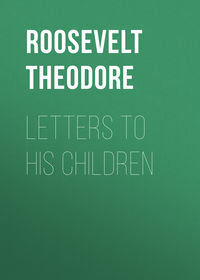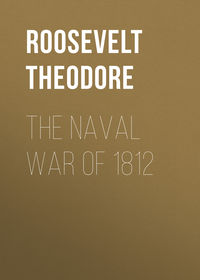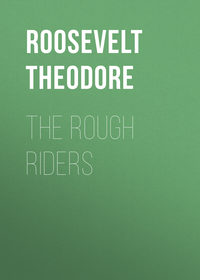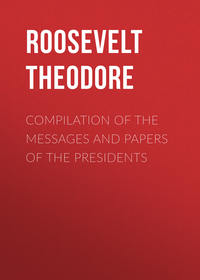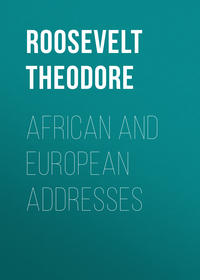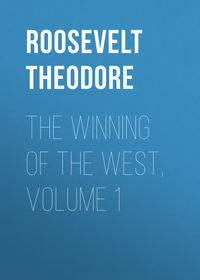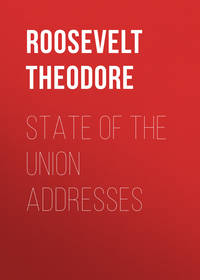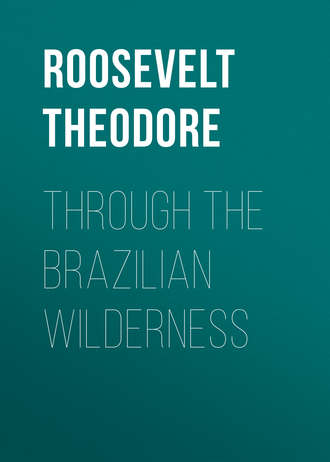 полная версия
полная версияThrough the Brazilian Wilderness
For personal baggage the light fibre sample case used by travelling men in the United States does admirably. The regulation fibre case with its metal binding sold for the purpose is too heavy and has the bad feature of swelling up under the influence of rain and dampness, often necessitating the use of an axe or heavy hammer to remove cover.
The ordinary fibre trunk is good for rail and steamer travel, but it is absolutely unpractical for mule-back or canoe. The fibre sample case could be developed into a container particularly fitted for exploration. The fibre should be soaked in hot paraffin and then hot- calendered or hot-pressed. This case could then be covered with waterproof canvas with throat opening like a duffel-bag.
The waterproof duffel-bags usually sold are too light in texture and wear through. A heavier grade should be used. The small duffel-bag is very convenient for hammock and clothing, but generally the thing wanted will be at the bottom of the bag! We took with us a number of small cotton bags. As cotton is very absorbent, I had them paraffined. Each bag was tagged and all were placed in the large duffel-bag. The light fibre case described above, made just the right size for mule pack, divided by partitions, and covered with a duffel-bag, would prove a great convenience.
The light steel boxes made in England for travellers in India and Africa would prove of value in South American exploration. They have the advantage of being insect and water proof and the disadvantage of being expensive.
It would be well if the traveller measured each case for personal equipment and computed the limit of weight that it could carry and still float. By careful distribution of light and heavy articles in the different containers, he could be sure of his belongings floating if accidentally thrown into the water.
It is not always possible to get comfortable native saddles. They are all constructed on heavy lines with thick padding which becomes water- soaked in the rainy season. A United States military saddle, with Whitman or McClellan tree, would be a positive luxury. Neither of them is padded, so would be the correct thing for all kinds of weather. The regulation army saddle-blanket is also advised as a protection for the mule's back. The muleteer should wash the saddle-blanket often. For a long mule-back trip through a game country, it would be well to have a carbine boot on the saddle (United States Army) and saddle-bags with canteen and cup. In a large pack-train much time and labor are lost every morning collecting the mules which strayed while grazing. It would pay in the long run to feed a little corn at a certain hour every morning in camp, always ringing a bell or blowing a horn at the time. The mules would get accustomed to receiving the feed and would come to camp for it at the signal.
All the rope that came to my attention in South America was three- strand hemp, a hard material, good for standing rigging but not good for tackle or for use aboard canoes. A four-ply bolt rope of best manilla, made in New Bedford, Mass., should be taken. It is the finest and most pliable line in the world, as any old whaler will tell you. Get a sailor of the old school to relay the coils before you go into the field so that the rope will be ready for use. Five eighths to seven eighths inch diameter is large enough. A few balls of marline come in conveniently as also does heavy linen fish-line.
A small-sized duffel-bag should be provided for each of the men as a container for hammock and net, spare clothing, and mess-kit. A very small waterproof pouch or bag should be furnished also for matches, tobacco, etc.
The men should be limited to one duffel-bag each. These bags should be numbered consecutively. In fact, every piece in the entire equipment should be thus numbered and a list kept in detail in a book.
The explorer should personally see that each of his men has a hammock, net, and poncho; for the native, if left unsupervised, will go into the field with only the clothing he has on.
FOOD—Though South America is rich in food and food possibilities, she has not solved the problem of living economically on her frontiers. The prices asked for food in the rubber districts we passed through were amazing. Five milreis (one dollar and fifty cents) was cheap for a chicken, and eggs at five hundred reis (fifteen cents) apiece were a rarity. Sugar was bought at the rate of one to two milreis a kilo—in a country where sugar-cane grows luxuriantly. The main dependence is the mandioc, or farina, as it is called. It is the bread of the country and is served at every meal. The native puts it on his meat and in his soup and mixes it with his rice and beans. When he has nothing else he eats the farina, as it is called, by the handful. It is seldom cooked. The small mandioc tubers when boiled are very good and are used instead of potatoes. Native beans are nutritious and form one of the chief foods.
In the field the native cook wastes much time. Generally provided with an inadequate cooking equipment, hours are spent cooking beans after the day's work, and then, of course, they are often only partially cooked. A kettle or aluminum Dutch oven should be taken along, large enough to cook enough beans for both breakfast and dinner. The beans should be cooked all night, a fire kept burning for the purpose. It would only be necessary then to warm the beans for breakfast and dinner, the two South American meals.
For meat the rubber hunter and explorer depends upon his rifle and fish-hook. The rivers are full of fish which can readily be caught, and, in Brazil, the tapir, capybara, paca, agouti, two or three varieties of deer, and two varieties of wild pig can occasionally be shot; and most of the monkeys are used for food. Turtles and turtle eggs can be had in season and a great variety of birds, some of them delicious in flavor and heavy in meat. In the hot, moist climate fresh meat will not keep and even salted meat has been known to spoil. For use on the Roosevelt expedition I arranged a ration for five men for one day packed in a tin box; the party which went down the Duvida made each ration do for six men for a day and a half, and in addition gave over half the bread or hardtack to the camaradas. By placing the day's allowance of bread in this same box, it was lightened sufficiently to float if dropped into water. There were seven variations in the arrangement of food in these boxes and they were numbered from 1 to 7, so that a different box could be used every day of the week. In addition to the food, each box contained a cake of soap, a piece of cheese-cloth, two boxes of matches, and a box of table salt. These tin boxes were lacquered to protect from rust and enclosed in wooden cases for transportation. A number in large type was printed on each. No. 1 was cased separately; Nos. 2 and 3, 4 and 5, 6 and 7 were cased together. For canoe travel the idea was to take these wooden cases off. I did not have an opportunity personally to experience the management of these food cases. We had sent them all ahead by pack- train for the explorers of the Duvida River. The exploration of the Papagaio was decided upon during the march over the plateau of Matto Grosso and was accomplished with dependence upon native food only.
DAILY RATION FOR FIVE MEN
SUN. MON. TUES. WED. THUR. FRI. SATRice 16 16 16
Oatmeal 13 13 13
Bread 100 100 100 100 100 100 100
Tea-biscuits 18 18 18
Gingersnaps 21 21 21 21
Dehydrated potatoes 11 11 11 11 11 11
Dehydrated onions 5 5 5 5 5 5
Erbswurst 8 8 8
Evaporated soups 6 6 6
Baked beans 25 25
Condensed milk 17 17 17 17 17 17 17
Bacon 44 44 44 44 44 44 44
Roast beef 56
Braised beef 56 56
Corned beef 70
Ox tongue 78
Curry and chicken 72
Boned chicken 61
Fruits: evaporated berries 5 5 5 5
Figs 20 20
Dates 16
Sugar 32 32 32 32 32 32 32
Coffee 10 10 10 10 10 10 10
Tea 5 5 5 5 5 5 5
Salt 4 4 4 4 4 4 4
Sweet chocolate 16
EACH BOX ALSO CONTAINED
Muslin, one yard 1 1 1 1 1 1 1
Matches, boxes 2 2 2 2 2 2 2
Soap, one cake 1 1 1 1 1 1 1
Above weights of food are net in avoirdupois ounces. Each complete ration with its tin container weighed nearly twenty-seven pounds. The five pounds over net weight of daily ration was taken up in tin necessary for protection of food. The weight of component parts of daily ration had to be governed to some extent by the size of the commercial package in which the food could be purchased on short notice. Austin, Nichols & Co., of New York, who supplied the food stores for my polar expedition, worked day and night to complete the packing of the rations on time.
The food cases described above were used on Colonel Roosevelt's descent of the Rio da Duvida and also by the party who journeyed down the Gy-Parana and Madeira Rivers. Leo Miller, the naturalist, who was a member of the last-named party, arrived in Manaos, Brazil, while I was there and, in answer to my question, told me that the food served admirably and was good, but that the native cooks had a habit of opening a number of cases at a time to satisfy their personal desire for special delicacies. Bacon was the article most sought for. Speaking critically, for a strenuous piece of work like the exploration of the Duvida, the food was somewhat bulky. A ration arrangement such as I used on my sledge trips North would have contained more nutritious elements in a smaller space. We could have done without many of the luxuries. But the exploration of the Duvida had not been contemplated and had no place in the itinerary mapped out in New York. The change of plan and the decision to explore the Duvida River came about in Rio Janeiro, long after our rations had been made out and shipped.
"Matte" the tea of Brazil and Paraguay, used in most of the states of South America, should not be forgotten. It is a valuable beverage. With it a native can do a wonderful amount of work on little food. Upon the tired traveller it has a very refreshing effect.
Doctor Peckolt, celebrated chemist of Rio de Janeiro, has compared the analysis of matte with those of green tea, black tea, and coffee and obtained the following result:
IN 1,000 PARTS OF GREEN TEA BLACK TEA COFFEE MATTE
Natural oil 7.90 0.06 0.41 0.01
Chlorophyl 22.20 18.14 13.66 62.00
Resin 22.20 34.40 13.66 20.69
Tannin 178.09 128.80 16.39 12.28
Alkaloids:
Mateina 4.50 4.30 2.66 2.50
Extractive substances 464.00 390.00 270.67 238.83
Cellulose and fibres 175.80 283.20 178.83 180.00
Ashes 85.60 25.61 25.61 38.11
Manner of preparation: The matte tea is prepared in the same manner as the Indian tea, that is to say, by pouring upon it boiling water during ten to fifteen minutes before using. To obtain a good infusion five spoonfuls of matte are sufficient for a litre of water.
Some experiments have been made lately with the use of matte in the German army, and probably it would be a valuable beverage for the use of our own troops. Two plates and a cup, knife, fork, and spoon should be provided for each member of the party. The United States Army mess- kit would serve admirably. Each man's mess-kit should be numbered to correspond with the number on his duffel-bag.
An aluminum (for lightness) cooking outfit, or the Dutch oven mentioned, with three or four kettles nested within, a coffee pot or a teapot would suffice. The necessary large spoons and forks for the cook, a small meat grinder, and a half dozen skinning knives could all be included in the fibre case. These outfits are usually sold with the cups, plates, etc., for the table. As before suggested, each member of the party should have his own mess-kit. It should not be carried with the general cooking outfit. By separating the eating equipments thus, one of the problems of hygiene and cleanliness is simplified.
RIFLES—AMMUNITION—A heavy rifle is not advised. The only animals that can be classed as dangerous are the jaguar and white-jawed peccary, and a 30-30 or 44 calibre is heavy enough for such game. The 44-calibre Winchester or Remington carbine is the arm generally used throughout South America, and 44 calibre is the only ammunition that one can depend upon securing in the field. Every man has his own preference for an arm. However, there is no need of carrying a nine or ten pound weapon when a rifle weighing only from six and three fourths to seven and one half pounds will do all that is necessary. I, personally, prefer the small-calibre rifle, as it can be used for birds also. The three-barrelled gun, combining a double shotgun and a rifle, is an excellent weapon, and it is particularly valuable for the collector of natural-history specimens. A new gun has just come on the market which may prove valuable in South America where there is such a variety of game, a four-barrel gun, weighing only eight and one fourth pounds. It has two shotgun barrels, one 30 to 44 calibre rifle and the rib separating the shotgun barrels is bored for a 22-calibre rifle cartridge. The latter is particularly adapted for the large food birds, which a heavy rifle bullet might tear. Twenty-two calibre ammunition is also very light and the long 22 calibre exceedingly powerful. Unless in practice it proves too complicated, it would seem to be a good arm for all-round use—sixteen to twenty gauge is large enough for the shotgun barrels. Too much emphasis cannot be placed upon the need of being provided with good weapons. After the loss of all our arms in the rapids we secured four poor, rusty rifles which proved of no value. We lost three deer, a tapir, and other game, and finally gave up the use of the rifles, depending upon hook and line. A 25 or 30 calibre high power automatic pistol with six or seven inch barrel would prove a valuable arm to carry always on the person. It could be used for large game and yet would not be too large for food birds. It is to be regretted that there is nothing in the market of this character.
We had our rifle ammunition packed by the U. M. C. Co. in zinc cases of one hundred rounds each, a metallic strip with pull ring closing the two halves of the box. Shot-cartridge, sixteen gauge, were packed the same way, twenty-five to the box.
The explorer would do well always to have on his person a compass, a light waterproof bag containing matches, a waterproof box of salt, and a strong, light, linen or silk fish-line with several hooks, a knife, and an automatic at his belt, with several loaded magazines for the latter in his pocket. Thus provided, if accidentally lost for several days in the forest (which often happens to the rubber hunters in Brazil), he will be provided with the possibility of getting game and making himself shelter and fire at night.
FISH—For small fish like the pacu and piranha an ordinary bass hook will do. For the latter, because of its sharp teeth, a hook with a long shank and phosphor-bronze leader is the best; the same character of leader is best on the hook to be used for the big fish. A tarpon hook will hold most of the great fish of the rivers. A light rod and reel would be a convenience in catching the pacu. We used to fish for the latter variety in the quiet pools while allowing the canoe to drift, and always saved some of the fish as bait for the big fellows. We fished for the pacu as the native does, kneading a ball of mandioc farina with water and placing it on the hook as bait. I should not be surprised, though, if it were possible, with carefully chosen flies, to catch some of the fish that every once in a while we saw rise to the surface and drag some luckless insect under.
CLOTHING—Even the experienced traveller when going into a new field will commit the crime of carrying too much luggage. Articles which he thought to be camp necessities become camp nuisances which worry his men and kill his mules. The lighter one can travel the better. In the matter of clothing, before the actual wilderness is reached the costume one would wear to business in New York in summer is practical for most of South America, except, of course, the high mountain regions, where a warm wrap is necessary. A white or natural linen suit is a very comfortable garment. A light blue unlined serge is desirable as a change and for wear in rainy weather.
Strange to relate, the South American seems to have a fondness for stiff collars. Even in Corumba, the hottest place I have ever been in, the native does not think he is dressed unless he wears one of these stiff abominations around his throat. A light negligee shirt with interchangeable or attached soft collars is vastly preferable. In the frontier regions and along the rivers the pajama seems to be the conventional garment for day as well as night wear. Several such suits of light material should be carried—the more ornamented and beautifully colored the greater favor will they find along the way. A light cravenetted mackintosh is necessary for occasional cool evenings and as a protection against the rain. It should have no cemented rubber seams to open up in the warm, moist climate. Yachting oxfords and a light pair of leather slippers complete the outfit for steamer travel. For the field, two or three light woollen khaki-colored shirts, made with two breast pockets with buttoned flaps, two pairs of long khaki trousers, two pairs of riding breeches, a khaki coat cut military fashion with four pockets with buttoned flaps, two suits of pajamas, handkerchiefs, socks, etc., would be necessary. The poncho should extend to below the knees and should be provided with a hood large enough to cover the helmet. It should have no cemented seams; the material recently adopted by the United States Army for ponchos seems to be the best. For footgear the traveller needs two pairs of stout, high hunting shoes, built on the moccasin form with soles. Hob nails should be taken along to insert if the going is over rocky places. It is also advisable to provide a pair of very light leather slipper boots to reach to just under the knee for wear in camp. They protect the legs and ankles from insect stings and bites. The traveller who enters tropical South America should protect his head with a wide-brimmed soft felt hat with ventilated headband, or the best and lightest pith helmet that can be secured, one large enough to shade the face and back of neck. There should be a ventilating space all around the head-band; the wider the space the better. These helmets can be secured in Rio and Buenos Aires. Head-nets with face plates of horsehair are the best protection against small insect pests. They are generally made too small and the purchaser should be careful to get one large enough to go over his helmet and come down to the breast. Several pairs of loose gloves rather long in the wrist will be needed as protection against the flies, piums and boroshudas which draw blood with every bite and are numerous in many parts of South America. A waterproof sun umbrella, with a jointed handle about six feet long terminating in a point, would be a decided help to the scientist at work in the field. A fine-meshed net fitting around the edge of the umbrella would make it insect proof. When folded it would not be bulky and its weight would be negligible. Such an umbrella could also be attached, with a special clamp, to the thwart of a canoe and so prove a protection from both sun and rain.
There are little personal conveniences which sometimes grow into necessities. One of these in my own case was a little electric flash- light taken for the purpose of reading the verniers of a theodolite or sextant in star observations. It was used every night and for many purposes. As a matter of necessity, where insects are numerous one turns to the protection of his hammock and net immediately after the evening meal. It was at such times that I found the electric lamp so helpful. Reclining in the hammock, I held the stock of the light under my left arm and with diary in my lap wrote up my records for the day. I sometimes read by its soft, steady light. One charge of battery, to my surprise, lasted nearly a month. When forced to pick out a camping spot after dark, an experience which comes to every traveller in the tropics in the rainy season, we found its light very helpful. Neither rain nor wind could put it out and the light could be directed wherever needed. The charges should be calculated on the plan of one for every three weeks. The acetylene lamp for camp illumination is an advance over the kerosene lantern. It has been found that for equal weight the carbide will give more light than kerosene or candle. The carbide should be put in small containers, for each time a box is opened some of the contents turns into gas from contact with the moist air.
TOOLS—Three or four good axes, several bill-hooks, a good hatchet with hammer head and nail-puller should be in the tool kit. In addition, each man should be provided with a belt knife and a machete with sheath. Collins makes the best machetes. His axes, too, are excellent. The bill-hook, called foice in Brazil, is a most valuable tool for clearing away small trees, vines, and under-growths. It is marvellous how quickly an experienced hand can clear the ground in a forest with one of these instruments. All of these tools should have handles of second-growth American hickory of first quality; and several extra handles should be taken along. The list of tools should be completed with a small outfit of pliers, tweezers, files, etc.—the character, of course, depending upon the mechanical ability of the traveller and the scientific instruments he has with him that might need repairs.
SURVEY INSTRUMENTS—The choice of instruments will depend largely upon the character of the work intended. If a compass survey will suffice, there is nothing better than the cavalry sketching board used in the United States Army for reconnaissance. With a careful hand it approaches the high degree of perfection attained by the plane-table method. It is particularly adapted for river survey and, after one gets accustomed to its use, it is very simple. If the prismatic compass is preferred, nothing smaller than two and one half inches in diameter should be used. In the smaller sizes the magnet is not powerful enough to move the dial quickly or accurately.
Several good pocket compasses must be provided. They should all have good-sized needles with the north end well marked and degrees engraved in metal. If the floating dial is preferred it should be of aluminum and nothing smaller than two and one half inches, for the same reason as mentioned above regarding the prismatic compass.
Expense should not be spared if it is necessary to secure good compasses. Avoid paper dials and leather cases which absorb moisture. The compass case should allow taking apart for cleaning and drying.
The regular chronometer movement, because of its delicacy, is out of the question for rough land or water travel. We had with us a small- sized half-chronometer movement recently brought out by the Waltham Company as a yacht chronometer. It gave a surprisingly even rate under the most adverse conditions. I was sorry to lose it in the rapids of the Papagaio when our canoes went down.
The watches should be waterproof with strong cases, and several should be taken. It would be well to have a dozen cheap but good watches and the same number of compasses for use around camp and for gifts or trade along the line of travel. Money is of no value after one leaves the settlements. I was surprised to find that many of the rubber hunters were not provided with compasses, and I listened to an American who told of having been lost in the depths of the great forest where for days he lived on monkey meat secured with his rifle until he found his way to the river. He had no compass and could not get one. I was sorry I had none to give; I had lost mine in the rapids.
For the determination of latitude and longitude there is nothing better than a small four or five inch theodolite not over fifteen pounds in weight. It should have a good prism eyepiece with an angle tube attached so it would not be necessary to break one's neck in reading high altitudes. For days we travelled in the direction the sun was going, with altitudes varying from 88° to 90°. Because of these high altitudes of the sun the sextant with artificial horizon could not be used unless one depended upon star observations altogether, an uncertain dependence because of the many cloudy nights.
BAROMETERS—The Goldsmith form of direct-reading aneroid is the most accurate portable instrument and, of course, should be compared with a standard mercurial at the last weather-bureau station.


